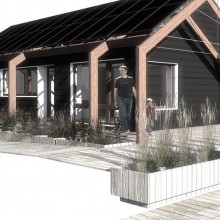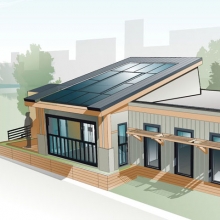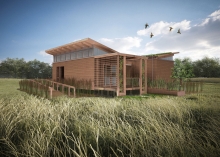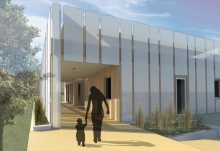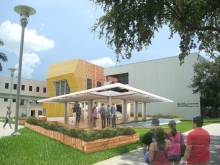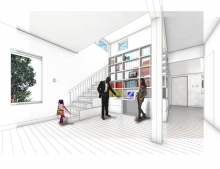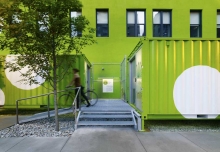Traditional farming requires huge inputs to sustain it, from water to potentially hazardous pesticides to fertilizers. After food is grown by conventional agricultural methods, it must be stored, refrigerated, and transported to the urban centers where it will be consumed, making traditional farming highly pollution-producing. Vertical Urban Agriculture has the potential to solve this problem and could lead to urban and environmental renewal on a fantastic scale for India’s cities.
Design News
2011 Solar Decathlon: Team Massachusetts' 4D Home
Because the Solar Decathlon competition stipulates that homes’ interiors measure less than 1,000 sq. ft., many teams choose young or retired couples as their target market. However, Team Massachusetts, which is comprised of students from the Massachusetts College of Art and Design and the University of Massachusetts at Lowell, created a home fit for a family of three. They articulated spaces with flexibility in mind in order to meet occupants’ changing needs throughout their lives: the 4D Home is three-dimensional over time.
In today’s on-the-go society, we have the capability of conducting work on smartphones to increase productivity. Beyond making calls, sending texts, and keeping track of our schedules, smartphone apps significantly enhance the user’s experience and enable them to conduct business outside the office proper. Particularly in the AEC industries, smartphone apps have become increasingly popular. These apps are more than mere gadgets; they provide functions similar to those of the tools that are traditionally used in the industry.
2011 Solar Decathlon: Tidewater Virginia's Unit 6 Unplugged
Many Solar Decathlon entries make futuristic propositions for green living, but the Tidewater Virginia team chose to design their house by using a familiar language. Their target market is the Tidewater region of southeastern Virginia, specifically the dense, middle-class neighborhoods of Norfolk, home to many military families. Designed as urban infill, Unit 6 Unplugged draws inspiration from its Arts and Crafts context and provides an affordable housing option for a working couple.
Adaptation: The Hawaii Preparatory Academy's Living Building
Living Building status was recently awarded to the Energy Lab on the campus of The Hawaii Preparatory Academy (HPA), a K–12 school on Hawaii’s main island. It is only the third project in the world to meet Living Building criteria.
2011 Solar Decathlon: University of Maryland's WaterShed
Solar Decathlon homes typically focus on the obvious – using energy from the sun. Students of the University of Maryland chose instead to highlight another precious resource often taken for granted: water. Their design, titled WaterShed, was inspired by the Chesapeake Bay watershed, the largest estuary in the United States with an area of 64,000 square miles spanning the states of Maryland, Delaware, New York, Pennsylvania, Virginia, and West Virginia. Suburban sprawl combined with the lack of stormwater management has threatened these natural ecosystems. WaterShed offers a sustainable model for living in the area, incorporating a range of water features and living elements. Leah Davies, who serves as one of the team leaders, explains that the home "mimics the cyclical nature of the Chesapeake Bay ecosystem by demonstrating the hydrologic cycle on a micro-scale."
Building Green on a Budget: Advice from Leading Architects
What are the best ways to build sustainably within budget constraints? We asked several leading architects for insight on this timely issue. Their collective advice on building green on a budget is to return to the fundamentals of good design and choose climate-appropriate materials that offer a quick payback.
2011 Solar Decathlon: The Ohio State University
Returning to the Solar Decathlon for the second consecutive competition, The Ohio State University team is building on the lessons learned from a Top 10 finish in the 2009 competition with a focus on efficient urban living. Designed as an urban infill house that could fit anywhere in Columbus, Ohio, enCORE is a 900 sq. ft., two-bedroom house that layers programmatic living spaces in an effort to recapture the spatial efficiencies of older homes. Abbie Faust, a Master's candidate in Architecture, explains, “We really wanted to emphasize how people can live in a smaller footprint. Our house condenses the family space by not losing the function, but emphasizing the core, of our house.”
2011 Solar Decathlon: Florida International University
perFORM[D]ance House
Teams participating in the 2011 Solar Decathlon strive to create high-tech, low-energy houses, but one team has created a home that also "dances." Florida International University's perFORM[D]ance House features movable facades that allow it to adapt to the needs of its occupants and environmental conditions. This flexible concept fosters connections between indoors and outdoors while mitigating Florida's hot, humid, and hurricane-prone climate.
2011 Solar Decathlon: A Vision Beyond the National Mall
Empowerhouse: a collaboration between Parsons The New School for Design, Milano The New School for Management and Urban Policy, and Stevens Institute of Technology
The Solar Decathlon competition requires teams to meet pages of rules, so not much time remains for considering what will become of the houses following their debut on the National Mall. However, the students of Parsons The New School for Design, Milano The New School for Management and Urban Policy, and Stevens Institute of Technology have a definite post-competition plan in mind: to provide housing for two families in the Deanwood neighborhood of Ward 7 in Washington, DC. The team has partnered with Habitat for Humanity and DC's Department of Housing and Community Development to build Empowerhouse, an affordable model for living that uses passive design strategies.
Challenges of Building Green: Certification Programs
Builders and project leaders are taking on a heightened level of responsibility when it comes to deciding whether to participate in certification programs, determining which programs best reflect their values and standards, and ultimately selling the idea and cost of certification to the owner. I spoke with several industry experts to get a better understanding of the challenges associated with building green and certification programs. Although opinions certainly vary, it seems that participation has not yet become an industry-wide expectation because some builders are not yet convinced that certification is necessary.
Shipping Containers: Creative Architecture at Work
Most of us don’t ever really think about shipping containers unless we work in logistics or caught the second season of The Wire. They have been steadily making their way into the architectural world -- their low cost and ambulatory nature making them appropriate in a variety of contexts, such as upscale housing and small workplaces or getaways. The creativity of these spaces emerges with the challenge of fitting design into a box, quite literally. Here, however, we will examine that creativity a bit further in a few other uses, while discussing shipping container design with Pittsburgh-based architect Gary P. Moshier of Moshier Studio.

